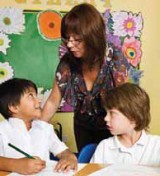Mathematically rich lesson starters need not take hours of planning, says Laurie Jacques...
Planning a mathematics lesson that is exciting, well paced and mathematically rich is challenging enough, so you may find you avoid spending too much time preparing for a 10 minute starter and stick to routine activities focused around recall. This does not have to be the case. In this article, I introduce some quick and easy ideas that you can use to ensure that even the first 10 minutes of your lesson can be mathematically rich without you, as the teacher, having to do very much at all.
It’s all too easy to get a ping-pong style of interaction going in the classroom. You ask a question, the pupils raise their hands or write the answer on their individual whiteboards and then you ask another question. Sound familiar? You are doing as much work as the pupils. How about you do less and the pupils do more?
 Take, for example, the question “What is 8 times 7?” Wouldn’t it be more interesting if you asked “Give me a pair of numbers whose product is 56”? When you ask that question there are many possible responses. 8 times 7 will probably be one of them. Of course there will also be 1 times 56 but there might also be ½ times 112. By opening up a question in this way you have a self-differentiating task and, over time, you will find that pupils will try and push themselves to find a smart answer. This will have the pupils thinking for much longer as you say “and another…”, and you are doing less work.
Take, for example, the question “What is 8 times 7?” Wouldn’t it be more interesting if you asked “Give me a pair of numbers whose product is 56”? When you ask that question there are many possible responses. 8 times 7 will probably be one of them. Of course there will also be 1 times 56 but there might also be ½ times 112. By opening up a question in this way you have a self-differentiating task and, over time, you will find that pupils will try and push themselves to find a smart answer. This will have the pupils thinking for much longer as you say “and another…”, and you are doing less work.
So now you have an idea of the type of questions that enable pupils to do the work and for you to do less (of course you now really have the time to listen and assess). The following question stems will provide you with a few more ideas for easy starter activities. These and other ideas can be found in Jill Mansergh’s book It Makes You Think, available from ATM (atm.org.uk).
Easy to use in the classroom, you just need to think about what you want examples of according to what your objective is, “Give me an example of”:
• a set of numbers whose mean is 5
• a quadrilateral
• an event whose probability is 1 in 6
• a pair of numbers whose difference is 16
• a rectangle whose area is 16cm2
 This is a favourite of mine. Here are three numbers.
This is a favourite of mine. Here are three numbers.
7 11 14
Which is the odd one out?
There is no ‘right’ answer to this. No “guess what the teacher is thinking”. Anything goes. What is required is for the pupils to think of a property that one of the three numbers has that the other two do not. You might have responses such as “7, because it’s a single digit”; “14, because it isn’t a prime number”; “11, because it’s symmetrical”. Of course you don’t have to use numbers, you could use shapes. For example:
‘square, circle, triangle’
This type task gets the pupils to think creatively and learn that there can be more than one answer to a mathematical question. You’ll find lots of mathematical vocabulary creeping in and opportunities for teaching points.
This involves providing a mathematical image/ fact and asking the pupils to change one thing according to a given condition. For example, “Change 12 ÷ 3 so it has a remainder of 3.” There are many answers to this. “Change the 3 to a 5” or “Change the 12 to a 14”. Clever pupils may be able to generalise and say “Change 12 to any number that is 2 more than (or 1 less) than a multiple of 3”.
Here’s another example. “Change this data so that the median is greater than the mean.”
4 6 8 10 15
This is a lot more tricky as changing one thing in a set of data could change the mean and median. Allow plenty of time for this and don’t forget to do it yourself too so you know what sorts of answers to expect!
This activity is useful for getting pupils to work interactively too, using Think, Pair, Share (from the Maths Out Loud series, BEAM publications, beam.co.uk). Here are two numbers.
20 21
 Ask pupils to think alone for a fixed time. They should write down two lists. One that describes the properties that are the same about the two numbers (e.g. “They both have a 2 in the tens place”) and one list that describes the differences. After the fixed time is up, ask pairs of pupils to compare their answers and add any ideas to their list that their partner has that they didn’t think of. (The first time you do this you may need to have a chat about the difference between copying and sharing ideas!) Ask the pupils to add ideas together in another fixed period of time. The first time you do this you may want to stop there, but eventually pupils will be good and sharing ideas and you can continue on to the next stage, which is to ask the pairs of pupils to share their ideas with another pair. The richness of this task often shows itself in the discussions that pupils will automatically engage in when deciding whether they have written down the same idea but using different words. There is lots of mathematical talk and you, the teacher are left listening to it.
Ask pupils to think alone for a fixed time. They should write down two lists. One that describes the properties that are the same about the two numbers (e.g. “They both have a 2 in the tens place”) and one list that describes the differences. After the fixed time is up, ask pairs of pupils to compare their answers and add any ideas to their list that their partner has that they didn’t think of. (The first time you do this you may need to have a chat about the difference between copying and sharing ideas!) Ask the pupils to add ideas together in another fixed period of time. The first time you do this you may want to stop there, but eventually pupils will be good and sharing ideas and you can continue on to the next stage, which is to ask the pairs of pupils to share their ideas with another pair. The richness of this task often shows itself in the discussions that pupils will automatically engage in when deciding whether they have written down the same idea but using different words. There is lots of mathematical talk and you, the teacher are left listening to it.
Of course, each of these ideas involves you creating a culture in your classroom where any answer is acceptable to throw in to the pot. Stating the obvious is fine. Being smart is fine. When pupils feel comfortable with this they will start to push themselves and, at this point, you might be ready to build some competitiveness into the answers by asking, “Give me your easiest/hardest answer.” Or “Give me an answer you think everyone else might/ might not have.”
By then you will already have a buzzing mathematical classroom for very little effort at the cost of just 10 minutes a day.
Before the session
• Ask teachers to register with the National Centre for Excellence in the Teaching of Mathematics (ncetm.org.uk) so that they can complete a self evaluation on Mathematics Specific Pedagogy. This includes a section on questioning in the ‘Teaching Strategies’ section.
• Read about questioning mathematically at ncetm.org.uk/mathemapedia/Questioning+Mathematically
During the session
• As a whole staff, work through the examples of question stems in this article.
• Encourage teachers to work independently and collaboratively.
• At the end of the session, ask teachers to plan the following week’s starters using the ideas and then try them out in class.
After the session
• Arrange another time to reconvene to discuss successes and challenges.
• Use this as a focus for subject leader observations at a later stage.
Laurie Jacques is an independent primary mathematics education consultant who has been a member of the Advisory Committee for Mathematics and Leading Maths Teacher for Kent LEA.
